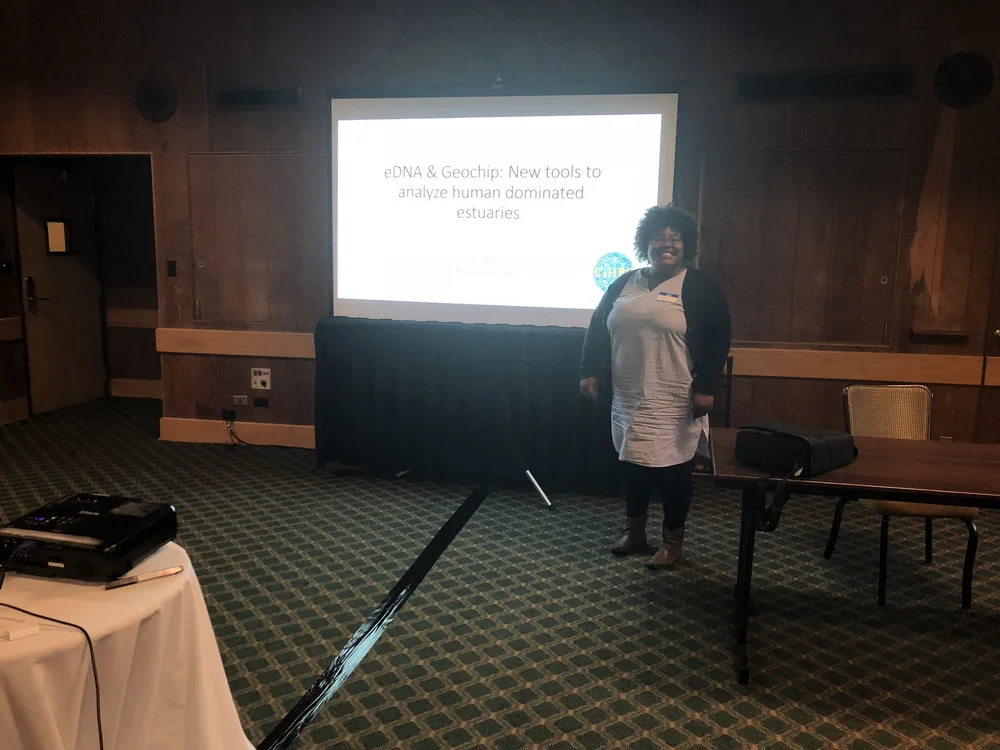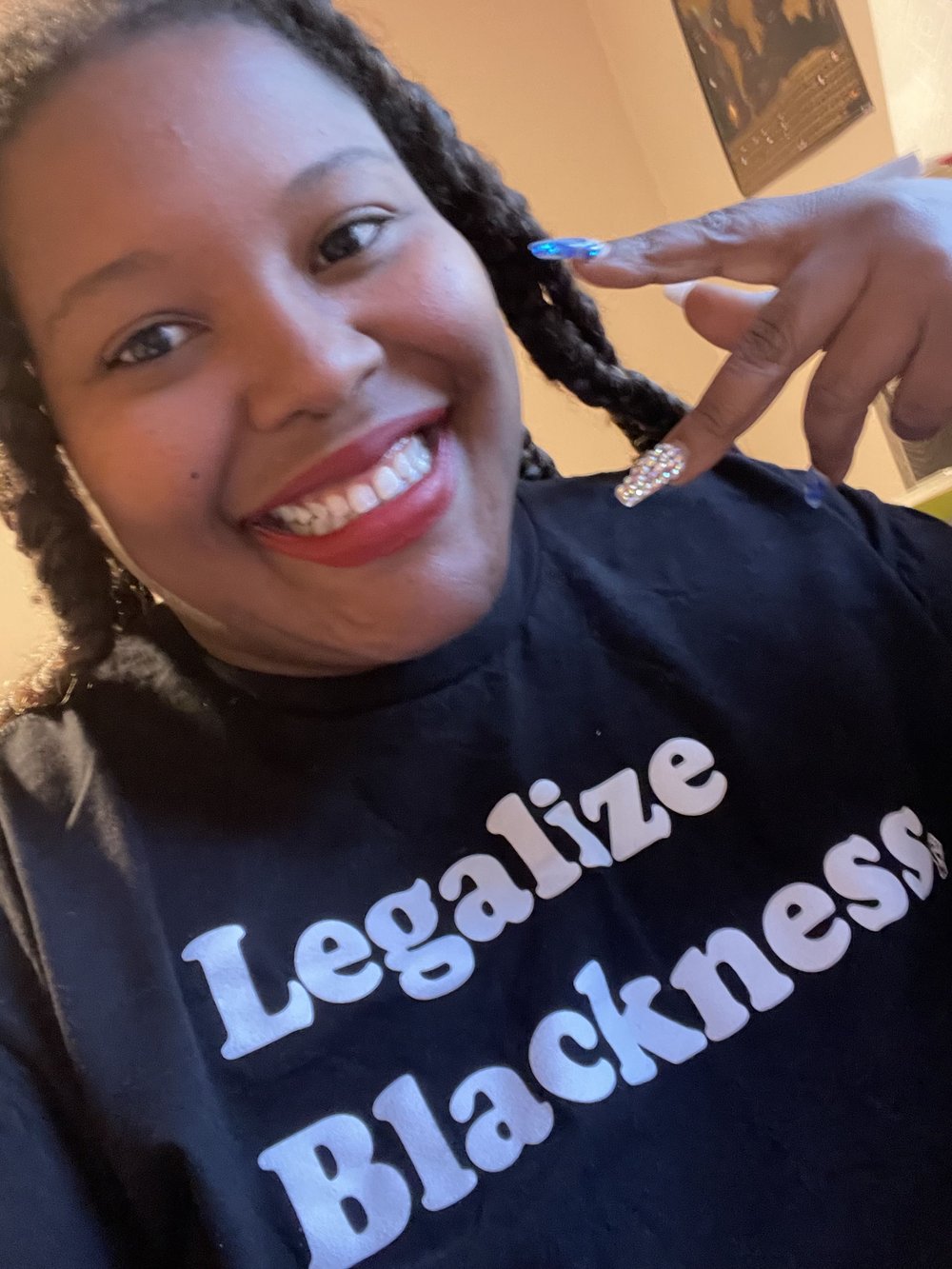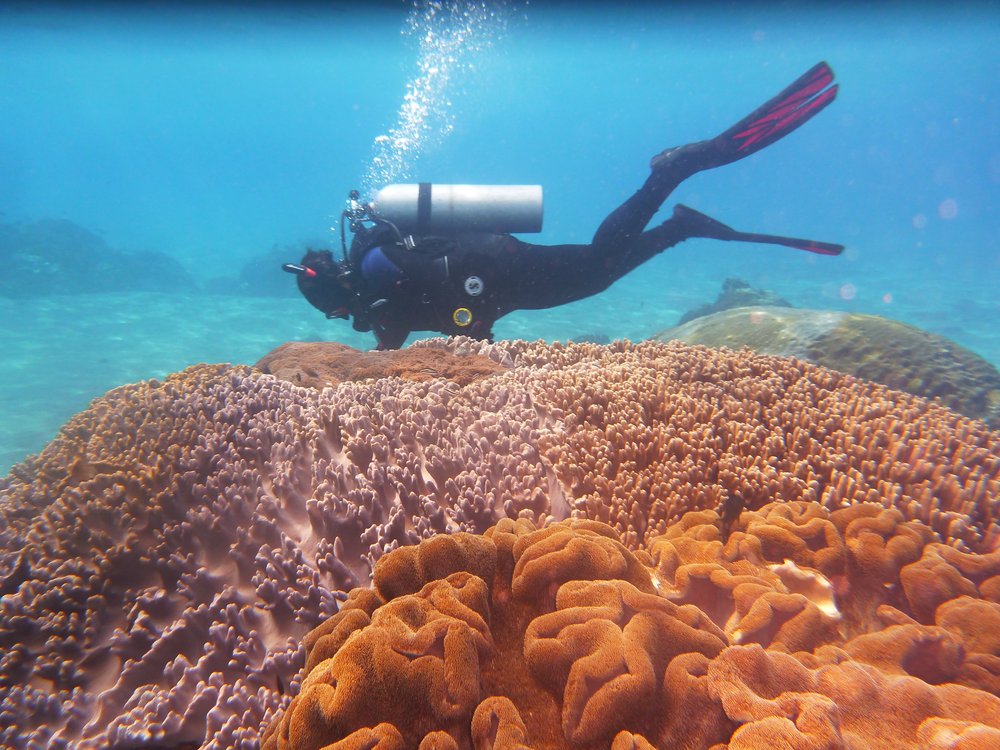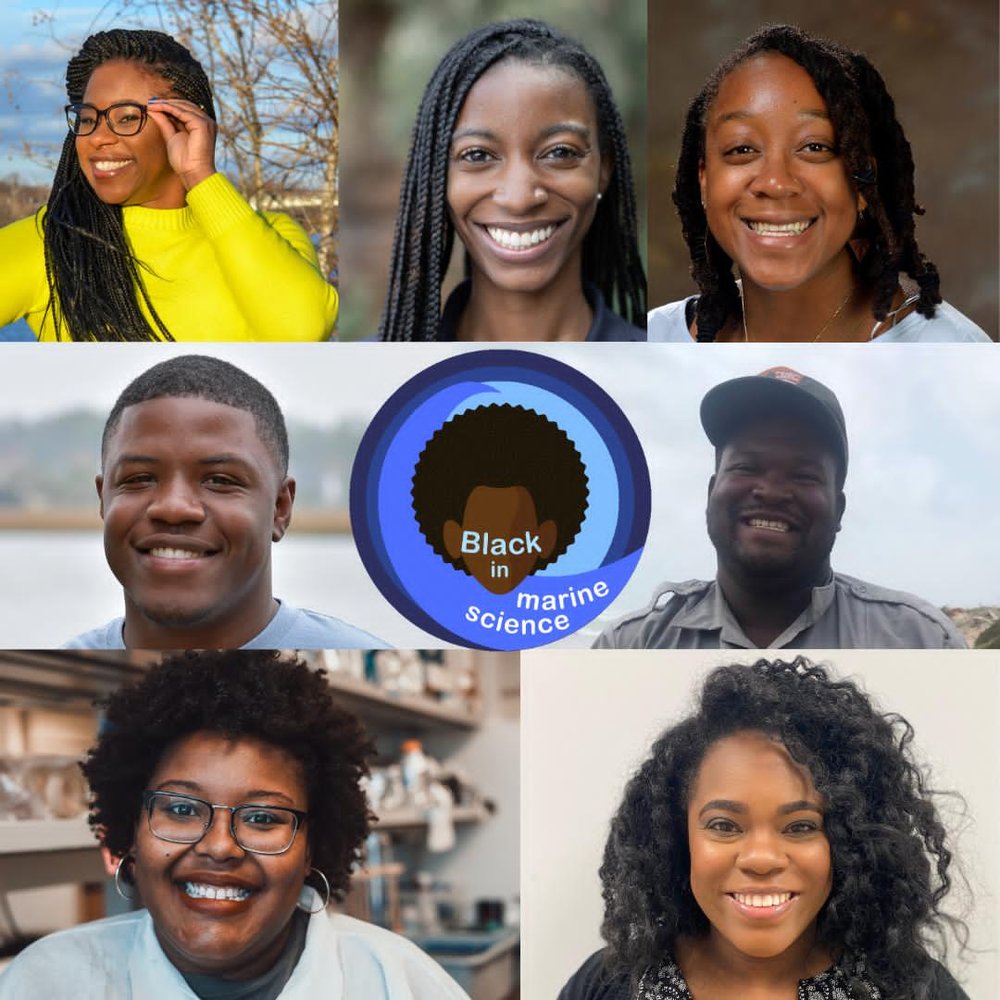Below is a conversation with Dr. Tiara Moore about Black in Marine Science, a nonprofit organization incorporated in Washington, of which she is the founder and CEO. Dr. Moore is also an employee of The Nature Conservancy in Washington, where she recently transitioned into a new role as Black in Marine Science Program Lead to change the game, change the face(s) of conservation, and steward a new partnership between the two organizations. The conversation has been lightly edited for brevity and flow.
Tell me about yourself?
I’m Dr. Tiara Moore. Originally, I’m from Greenwood, South Carolina, so I’ve got a little bit of a southern accent. People usually ask me how I got into science—I went into undergrad with a pre-med track thinking I’d be a pediatrician; but I realized it wasn’t for me and I changed what I was doing. I took this tropical ecology class, which, I only took it because they were going to Costa Rica for spring break [laughing]. So I went to Costa Rica, and we were on this boat collecting samples, doing experiments, and it was really fun. There were these senior scientists there, and that’s how I learned about marine science and how science could be a career. From there, I went on to make it my life’s work—I got my masters then my Ph.D. and did research all over the world.
Dr. Moore diving in the coral triangle near Bali, Indonesia
How did you end up at TNC?
My background is in marine ecology and marine science. I was interested in whole ecosystems and biodiversity and how things were interacting, so I started using environmental DNA, or eDNA, as a tool to understand that. With eDNA, you can take a small sample of water or soil, extract the DNA, and get a census of the ecosystem and what organisms have been there. So I had picked up this eDNA tool as part of my work while I was finishing up my Ph.D. at UCLA.
Then, I was at a conference where I was talking about eDNA and I met Phil Levin [Lead Scientist here at TNC in Washington]. He asked me if I could use this eDNA tool in a forest. I said, “Yeah, I’m sure you could…” and we talked through the methods, but then he asked me, “Well, could you do it?”
And [laughing] I mean, I was a marine scientist, we were at a marine science conference, so I was wondering, “Why are you asking me about a forest??” [laughing]. But I was a Ph.D. student, I was finishing up, I was looking for a job. He saw that eDNA was a tool, and I had the skills with it, and he was wondering if the tool could be used in a different ecosystem. So I ended up doing my post-doc in partnership with the University of Washington and TNC trying to understanding the biodiversity of the restoration efforts in the Ellsworth forest using eDNA.
Dr. Moore presenting on eDNA in 2018
What’s BIMS, how did it come into existence?
Black in Marine Science—BIMS! BIMS is a nonprofit organization that’s aimed at uplifting, celebrating, and inspiring people, and looking at how we can build up and change the face of the environmental field.
BIMS came from a lot of different things. It really started because of 2020. 2020 was… [oooohh]… 2020 was very interesting for me as a Black woman, for the whole country as living, breathing human beings. So, how do I start? I think there’s a story of how BIMS started publicly, but also the story of why I was ready to lead BIMS. There’s two different versions.
So, how BIMS started publicly. There was George Floyd and the racial awakening that not only occurred across the country, but also specifically in STEM. Then there was also the situation that happened with a Black birder in Central Park and the white woman that called the police. One thing that came from that was a group of Black birders on social media got together to create Black Birders Week to turn the myth around and say, “Hey, you shouldn’t call the police on Black people when they’re outside birding. Black people bird.” So a whole week was dedicated to Black people birding. From that event, from August to about October of 2020, there were all these weeks of outreach—Black in Botany, Black in Physics, Black in Neuroscience. The whole goal was similar to Black Birders Week, to say, “Here are all these STEM fields, Black people aren’t seen to be in those fields—they’re seen as predators as we saw in the George Floyd situation—but actually, no, we’re scientists, we’re botanists, we’re neuroscientists.”

All that was happening, and I was excited about it, but I wasn’t seeing a Black in marine science week. I tweeted about it and it got a huge response. People were like, “Oh, yeah, there’s Black people doing marine science?? Tell us more!” And when you tweet something, you have to become a leader for it, so I took it on and we created a whole week of outreach last year to highlight Black folks in marine science. It was an awesome, big week last year—so big, in fact, that we decided to turn it into a nonprofit.
Personally, the reason I was able to step up and lead Black in Marine Science, was because of my personal experiences as a Black woman, at the Ph.D. level, and on the science team here—I’ll be transparent. When I was in graduate school, I definitely had some racially charged experiences, but me being naive, I thought it was just something that happened in grad school, that it’s a thing that happens just to students. There were comments about, “Oh, you’re just on a diversity scholarship.” Comments like that. So that was very rough, where you’re at this place like UCLA where it’s super prestigious and people only think you’re there because of a diversity scholarship. So that was my background, where I was used to this weird kind of abuse, but I figured once I got my Ph.D., it’d be “I’m Dr. Moore, I belong here.”
Then I moved to Seattle. First of all, there weren’t any Black people in sight. In my neighborhood it was weird—we had key fobs for our building, and I had neighbors closing the door on me, even when I had my key fob out. People calling in and reporting, “Oh, there’s someone in the mail room” when it was just me getting my mail. Stuff like that.
Some experiences on the team were rough, too. I felt excluded. Things happened that weren’t understood or seen—I was the only Black woman on the team. I was encouraged to report stuff, but then nothing came of it because I was the only one reporting it. I’m a scientist, so if you’d told me from the beginning that n = 1 wasn’t going to be enough, we could’ve stopped the conversation there and never reported anything. Because it was an n of 1, it was seen as “there’s no racism here.” That was really rough, Dr. Moore and still experiencing stuff like that. At that point, I wanted to walk away.
Black in Marine Science Board of Directors. Left to right, top: Dr. Jeanette Davis, Symone Barkley, Dr. Camille Gaynus; middle: Kris Howard, Alex Troutman; bottom: Dr. Tiara Moore, Leslie Townsell
Luckily, I had met some other Black folks in marine science throughout my career. And at one point, I was talking to one of my really good friends about our experiences—they were at a prestigious school, and here I was at a prestigious nonprofit, and she was having similar stuff going on. Here we were, two Black doctors, getting into spaces that claim they want people who look like us to get into, and then we’re getting treated like we don’t belong there.
Me seeing that, seeing pure sadness in others’ eyes, and having similar experiences, it was like, “Okay, are we going to walk away, or are we going to take up space?” That’s where I was, personally, to start BIMS. I knew places could be better.
>
“Here we were, two Black doctors, getting into spaces that claim they want people who look like us to get into, and then we’re getting treated like we don’t belong there. ”
I was able to build BIMS the way I did because I’d completely disengaged—by stepping away to prioritize my wellbeing, I was able to build community and BIMS. After BIMS was built, hope came back. And there came clout with it, too. So I was feeling more fulfilled from the BIMS work.
It was also around the time my post-doc was ending, so I was looking around at different jobs. At these places I was considering, I went to staff pages, and they were all generally white—there were very few brown faces. I kept getting discouraged. Did I want to go through all this again? Is this what the outlook looks like to be a scientist?
Then I won this award, Black Voices for Black Justice. They gave me $50,000 to do whatever I wanted to do. That’s when I made the decision to not apply for any jobs—I was gonna finish my post-doc, ride out, and see what I could do with BIMS and the money I’d just gotten. To me, in my streets, $50K is a lot. I was asked, “How long do you think that’s going to last?” and I was like, “I’d rather starve than continue like this.” That’s how transparent I had to be.
I love the relationship that’s been built since—if not for the realness in those conversations, I don’t think the partnership [between BIMS and TNC] would have come to fruition. I wanted to take a leap with BIMS and build it. I get so much joy from the BIMS organization and community. The community is there, the community wants more content and more programming for us, and I need to figure out how to do that. Applying for jobs wasn’t going to work for me. I didn’t want letters of recommendation for jobs. I do believe that Phil was the first one to suggest the BIMS and TNC partnership; basically, how could we work inside and with TNC to build some type of partnership with BIMS. It evolved a bit from what I originally thought—where there could be a grant to BIMS from TNC, but I’d still leave TNC—but it turned into more, where I’m still a TNC employee supporting BIMS. I do believe there’s a true belief in BIMS as an organization—BIMS is poppin’, we have done a lot of good work, and I think there is some true support [from TNC].
What’s your relationship to BIMS?
Dr. Moore repping Black in Marine Science
BIMS is my baby! I’m the founder and CEO. My goal is to meet the mission of BIMS—to celebrate Black marine scientists, spread environmental awareness, and inspire the next generation of scientific thought leaders. And, ultimately, change the face(s) of who people see as scientists.
Honestly, it was a heartbreak around the world the way that George Floyd was treated. What was so revealing for me is that that’s just the way that Black people are seen—as folks that don’t belong in these spaces and are seen as predators. At the end of the day, if I walk outside, it isn’t “Oh! There goes Dr. Moore. She has a Ph.D.!” No. It’s, “She’s just another Black person, let’s go kneel on her neck.” Because I go outside with my hoodie on, in my sweats and my Crocs—all of a sudden, I didn’t go to UCLA, I haven’t won all these awards, I haven’t done all this stuff.
To have experienced it first-hand, when you “earn” a seat at the table but then it’s like “Nah baby-girl, this seat ain’t for you. You thought.” It was so heartbreaking. So that’s what we really want to change. To say hey, we can be these other things, we can belong in these spaces. It’s about changing the culture of science, and especially in conservation and environmental science. I think you see more Black folks in medical fields than you do in conservation and marine science, so it’s time for all that to change.
What’s TNC’s relationship with BIMS?
It’s two-fold. It’s through me, because I am a TNC employee. But I also think it is an opportunity for TNC to support a grassroots organization—it’s an opportunity for us (TNC) to put resources into the communities we say we want to support, resources to really see people and nature thrive. I think it needs to be targeted efforts for Black communities, because we know they’ve been impacted for long, we know that practices specifically at TNC have harmed Black people. I think it’s time for us to really put our money where our mouth is, to say, “Hey, what can we do to really enrich these communities?”
How can people get connected with BIMS?
Lots of ways! Our website, bims.org, @blackinmarsci on Twitter, @blackinmarinescience on Instagram, and we have lots of content on our YouTube channel. People can connect with us on any of those, or email info@bims.org, too.
You can support BIMS by donating here: bims.org/donate
If you’re a Black marine scientist, you can join as a member – with that, you get access to our BIMS community and can connect with other Black marine scientists.
Note: we thank Dr. Tiara Moore for her time, leadership, and wisdom. This was the first of a two-part Q&A with Dr. Moore about her, her work, Black in Marine Science, and more. You can read the second part here.
All photos courtesy of Dr. Tiara Moore.


